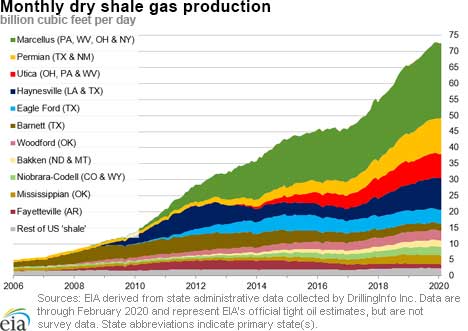In the News:
Crude oil market conditions contributing to higher natural gas prices at the Waha Hub
Although natural gas prices at the Waha natural gas trading hub in the Permian Basin, which includes West Texas and Southeast New Mexico, remain relatively low, they have been up more than $1 per million British thermal units ($/MMBtu) during the past two weeks because of global crude oil market conditions and declining crude oil prices. Price increases have affected both spot and forward values of Waha Hub natural gas. In recent years, the natural gas price at the Waha Hub has often been the lowest in North America for two reasons: hydrocarbon production in the Permian Basin has exceeded available takeaway pipeline capacity, and a significant amount of natural gas production in the Permian region is associated with oil production. As a result of this market imbalance, producers/marketers have had to compete to transport natural gas in a constrained network, and oil market fundamentals have had a pronounced effect on the Waha Hub price.
The Waha Hub spot natural gas price was negative as recently as March 3, but on March 11, it reached as high as $0.96/MMBtu. The forward or futures market for Waha Hub natural gas is up, too. Since February 26, when the Nymex natural gas futures contract at Henry Hub expired, the April–October summer strip for natural gas at the Waha Hub increased from -$0.05/MMBtu to $0.85/MMBtu on March 11, according to S&P Market Intelligence.
Spot natural gas prices at the Waha hub frequently traded negative in 2019 because of takeaway constraints in the Permian Basin. Since the 2.0 billion cubic feet per day (Bcf/d) Gulf Coast Express Pipeline was commissioned last year, Waha spot prices have gone negative less frequently. However, this additional takeaway capacity quickly became utilized, and in recent months, led to the Waha price differential to the Henry Hub widening again.
Crude oil prices have experienced significant volatility and price declines since the final week in February amid concerns over the economic effects of the 2019 novel coronavirus disease (COVID-19). More recently, markets fell after the Organization of the Petroleum Exporting Countries (OPEC) and partners failed to reach an agreement to continue crude oil production cuts. EIA’s Short-term Energy Outlook forecasts that low crude oil prices and the ongoing global pandemic are likely to reduce demand for both petroleum products and natural gas, thereby pushing prices and production levels down for both commodities in the coming months and into 2021.
Overview:
(For the week ending Wednesday, March 18, 2020)
- Natural gas spot prices fell at most locations this report week (Wednesday, March 11, to Wednesday, March 18). The Henry Hub spot price fell from $1.92 per million British thermal units (MMBtu) last Wednesday to $1.65/MMBtu yesterday.
- At the New York Mercantile Exchange (Nymex), the price of the April 2020 contract decreased 27¢, from $1.878/MMBtu last Wednesday to $1.604/MMBtu yesterday, the lowest front-month price since March 2016. The price of the 12-month strip averaging April 2020 through March 2021 futures contracts declined 15¢/MMBtu to $2.083/MMBtu.
- The net withdrawal from working gas totaled 9 billion cubic feet (Bcf) for the week ending March 13. Working natural gas stocks totaled 2,034 Bcf, which is 76% more than the year-ago level and 16% more than the five-year (2015–19) average for this week.
- The natural gas plant liquids (NGPL) composite price at Mont Belvieu, Texas, fell by 57¢/MMBtu, averaging $3.12/MMBtu for the week ending March 18. The prices of heavier NGPLs -- natural gasoline, butane, and isobutane -- fell, by 32%, 20%, and 16%, and lighter NGPLs ethane and propane fell by 11%, and 7%, respectively. The prices of natural gasoline, butane, isobutane, ethane, and propane all fell, by 32%, 20%, 16%, 11%, and 7%, respectively.
- According to Baker Hughes, for the week ending Tuesday, March 10, the natural gas rig count decreased by 2 to 107. The number of oil-directed rigs rose by 1 to 683. The total rig count decreased by 1, and it now stands at 792.
Prices/Supply/Demand:
Prices fall with warming temperatures. This report week (Wednesday, March 11, to Wednesday, March 18), the Henry Hub spot price fell 27¢ from $1.92/MMBtu last Wednesday to a low of $1.65/MMBtu yesterday. Temperatures across the Lower 48 states were warmer than normal across the eastern seaboard and Texas and cooler than normal in the Pacific Northwest. At the Chicago Citygate, the price decreased 30¢ from $1.79/MMBtu last Wednesday to $1.49/MMBtu yesterday.
California prices are down. The price at PG&E Citygate in Northern California fell 4¢, down from a high of $2.84/MMBtu last Wednesday to $2.80/MMBtu yesterday. The price at SoCal Citygate in Southern California decreased 29¢ from $2.40/MMBtu last Wednesday to a low of $2.11/MMBtu yesterday.
Northeast prices fall with warmer spring temperatures. At the Algonquin Citygate, which serves Boston-area consumers, the price went down 33¢ from a high of $1.75/MMBtu last Wednesday to a low of $1.42/MMBtu yesterday. At the Transcontinental Pipeline Zone 6 trading point for New York City, the price decreased 39¢ from a high of $1.69/MMBtu last Wednesday to a low of $1.30/MMBtu yesterday.
The Tennessee Zone 4 Marcellus spot price decreased 33¢ from $1.52/MMBtu last Wednesday to $1.19/MMBtu yesterday. The price at Dominion South in southwest Pennsylvania fell 29¢ from $1.52/MMBtu last Wednesday to $1.23/MMBtu yesterday.
Permian Basin prices are relatively stable throughout the week. The price at the Waha Hub in West Texas, which is located near Permian Basin production activities, reached a high of $0.96/MMBtu last Wednesday, 96¢/MMBtu lower than the Henry Hub price. Yesterday, the price at the Waha Hub averaged $0.89/MMBtu, 76¢/MMBtu lower than the Henry Hub price. See the In The News section for further analysis.
Supply rises slightly. According to data from IHS Markit, the average total supply of natural gas rose by 1% compared with the previous report week. Dry natural gas production grew by 1% compared with the previous report week. Average net imports from Canada increased by 12% from last week as U.S. exports into Canada declined, according to data from Genscape.
Demand rises, driven by gains in the power sector. Total U.S. consumption of natural gas rose by 3% compared with the previous report week, according to data from IHS Markit. Natural gas consumed for power generation climbed by 8% week over week in the low natural gas price environment. Industrial sector consumption increased by 1% week over week. In the residential and commercial sectors, consumption declined overall by 1%. Natural gas exports to Mexico increased 1%.
U.S. LNG exports increase week over week. Sixteen LNG vessels (five from Sabine Pass, three from each Cameron, Corpus Christi, and Freeport, and two from Cove Point) with a combined LNG-carrying capacity of 59 Bcf departed the United States between March 12 and March 18, 2020, according to shipping data provided by Marine Traffic. Fog conditions were reported around the port of Sabine Pass, affecting ship traffic, according to SP Global Platts.
Storage:
The net withdrawal from storage totaled 9 Bcf for the week ending March 13, compared with the five-year (2015–19) average net withdrawal of 63 Bcf and last year's net withdrawal of 91 Bcf during the same week. Working natural gas stocks totaled 2,034 Bcf, which is 281 Bcf more than the five-year average and 878 Bcf more than last year at this time.
According to The Desk survey of natural gas analysts, estimates of the weekly net change to working natural gas stocks ranged from a net withdrawal of 14 Bcf to a net injection of 7 Bcf, with a median estimate of a net withdrawal of 6 Bcf.
The average rate of withdrawal from storage is 13% lower than the five-year average so far in the withdrawal season (November through March). If the rate of withdrawal from storage matched the five-year average of 3.1 Bcf/d for the remainder of the withdrawal season, the total inventory would be 1,978 Bcf on March 31, which is 281 Bcf higher than the five-year average of 1,697 Bcf for that time of year.
More storage data and analysis can be found on the Natural Gas Storage Dashboard and the Weekly Natural Gas Storage Report.
See also:
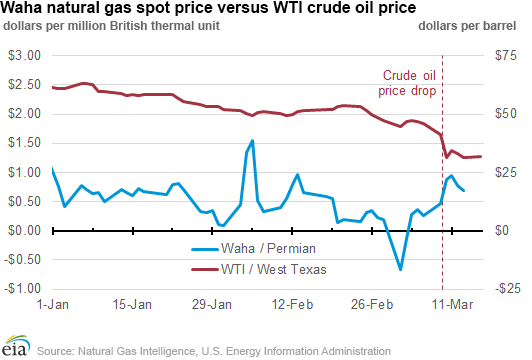
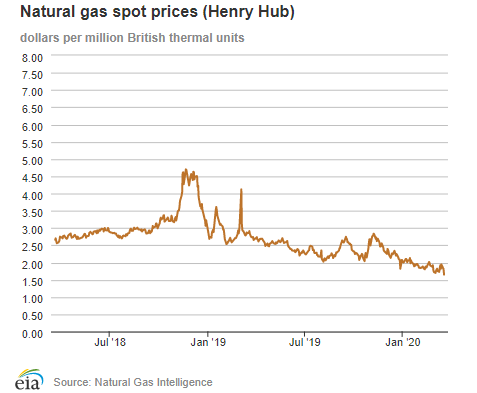
| Spot Prices ($/MMBtu) | Thu, 12-Mar |
Fri, 13-Mar |
Mon, 16-Mar |
Tue, 17-Mar |
Wed, 18-Mar |
|---|---|---|---|---|---|
| Henry Hub | 1.82 | 1.95 | 1.85 | 1.82 | 1.65 |
| New York | 1.51 | 1.68 | 1.46 | N/A | 1.30 |
| Chicago | 1.67 | 1.75 | 1.68 | 1.65 | 1.49 |
| Cal. Comp. Avg.* | 2.07 | 2.13 | 2.25 | 2.29 | 2.00 |
| Futures ($/MMBtu) | |||||
| April Contract | 1.841 | 1.869 | 1.815 | 1.729 | 1.604 |
| May Contract | 1.885 | 1.901 | 1.853 | 1.769 | 1.647 |
| *Avg. of NGI's reported prices for: Malin, PG&E Citygate, and Southern California Border Avg. | |||||
| Source: NGI's Daily Gas Price Index | |||||
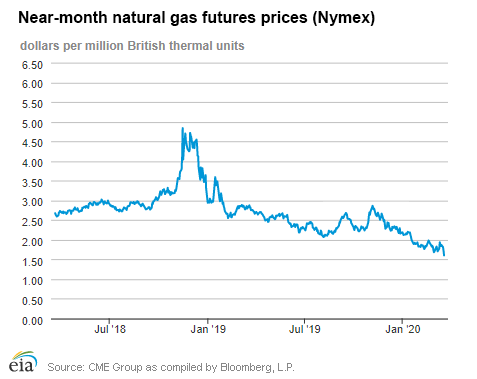
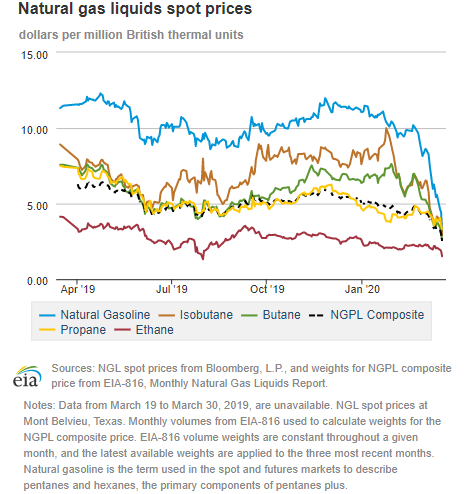
| U.S. natural gas supply - Gas Week: (3/12/20 - 3/18/20) | |||
|---|---|---|---|
Average daily values (Bcf/d): |
|||
this week |
last week |
last year |
|
| Marketed production | 106.7 |
106.0 |
99.2 |
| Dry production | 94.8 |
94.2 |
88.1 |
| Net Canada imports | 4.1 |
3.7 |
5.2 |
| LNG pipeline deliveries | 0.1 |
0.2 |
0.1 |
| Total supply | 99.0 |
98.1 |
93.4 |
|
Source: IHS Markit | |||
| U.S. natural gas consumption - Gas Week: (3/12/20 - 3/18/20) | |||
|---|---|---|---|
Average daily values (Bcf/d): |
|||
this week |
last week |
last year |
|
| U.S. consumption | 83.5 |
81.3 |
81.8 |
| Power | 30.3 |
28.0 |
24.7 |
| Industrial | 25.9 |
25.7 |
24.2 |
| Residential/commercial | 27.3 |
27.6 |
32.9 |
| Mexico exports | 5.6 |
5.5 |
4.8 |
| Pipeline fuel use/losses | 7.0 |
6.9 |
6.6 |
| LNG pipeline receipts | 8.0 |
8.0 |
5.5 |
| Total demand | 104.1 |
101.8 |
98.7 |
|
Source: IHS Markit | |||
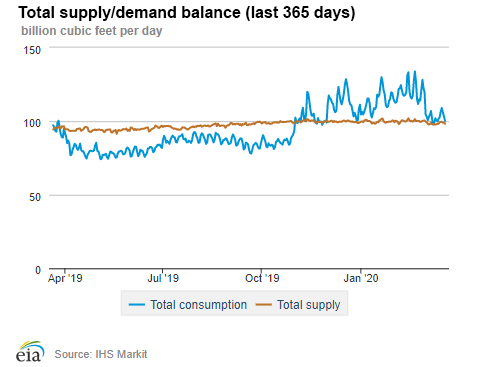
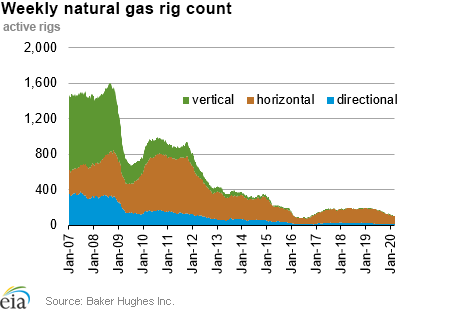
| Rigs | |||
|---|---|---|---|
Tue, March 10, 2020 |
Change from |
||
last week |
last year |
||
| Oil rigs | 683 |
0.1% |
-18.0% |
| Natural gas rigs | 107 |
-1.8% |
-44.6% |
| Note: Excludes any miscellaneous rigs | |||
| Rig numbers by type | |||
|---|---|---|---|
Tue, March 10, 2020 |
Change from |
||
last week |
last year |
||
| Vertical | 31 |
-8.8% |
-42.6% |
| Horizontal | 713 |
0.7% |
-21.4% |
| Directional | 48 |
-5.9% |
-26.2% |
| Source: Baker Hughes Inc. | |||
| Working gas in underground storage | ||||
|---|---|---|---|---|
Stocks billion cubic feet (Bcf) |
||||
| Region | 2020-03-13 |
2020-03-06 |
change |
|
| East | 412 |
426 |
-14 |
|
| Midwest | 512 |
529 |
-17 |
|
| Mountain | 96 |
97 |
-1 |
|
| Pacific | 199 |
200 |
-1 |
|
| South Central | 814 |
791 |
23 |
|
| Total | 2,034 |
2,043 |
-9 |
|
|
Source: Form EIA-912, Weekly Underground Natural Gas Storage Report | ||||
| Working gas in underground storage | |||||
|---|---|---|---|---|---|
Historical comparisons |
|||||
Year ago (3/13/19) |
5-year average (2015-2019) |
||||
| Region | Stocks (Bcf) |
% change |
Stocks (Bcf) |
% change |
|
| East | 250 |
64.8 |
325 |
26.8 |
|
| Midwest | 273 |
87.5 |
400 |
28.0 |
|
| Mountain | 63 |
52.4 |
110 |
-12.7 |
|
| Pacific | 98 |
103.1 |
198 |
0.5 |
|
| South Central | 472 |
72.5 |
721 |
12.9 |
|
| Total | 1,156 |
76.0 |
1,753 |
16.0 |
|
| Source: Form EIA-912, Weekly Underground Natural Gas Storage Report | |||||
| Temperature – heating & cooling degree days (week ending Mar 12) | ||||||||
|---|---|---|---|---|---|---|---|---|
HDD deviation from: |
CDD deviation from: |
|||||||
| Region | HDD Current |
normal |
last year |
CDD Current |
normal |
last year |
||
| New England | 155 |
-61 |
-95 |
0 |
0 |
0 |
||
| Middle Atlantic | 147 |
-55 |
-79 |
0 |
0 |
0 |
||
| E N Central | 158 |
-55 |
-66 |
0 |
0 |
0 |
||
| W N Central | 157 |
-56 |
-77 |
0 |
-1 |
0 |
||
| South Atlantic | 93 |
-30 |
-27 |
10 |
0 |
-3 |
||
| E S Central | 87 |
-30 |
-12 |
1 |
-3 |
0 |
||
| W S Central | 43 |
-29 |
0 |
18 |
9 |
-2 |
||
| Mountain | 127 |
-40 |
-47 |
1 |
0 |
0 |
||
| Pacific | 95 |
1 |
-34 |
0 |
-1 |
0 |
||
| United States | 122 |
-38 |
-50 |
4 |
0 |
-1 |
||
|
Note: HDD = heating degree day; CDD = cooling degree day Source: National Oceanic and Atmospheric Administration | ||||||||
Average temperature (°F)
7-day mean ending Mar 12, 2020
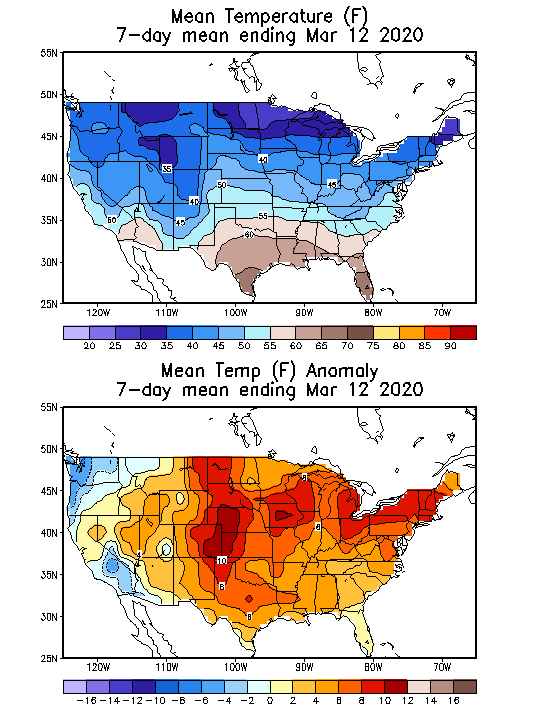
Source: National Oceanic and Atmospheric Administration
Deviation between average and normal (°F)
7-day mean ending Mar 12, 2020

Source: National Oceanic and Atmospheric Administration

